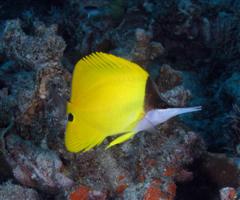Butterflyfish - Long Nose
Longnose Butterfly, Forceps Butterfly Fish Scientific Name: Forcipiger flavissimus
Fri, 4th April, 2025 - 4:30 pm GMT
Sponsor Ads:

Alternative Name
Longnose Butterfly, Forceps Butterfly Fish Scientific Name: Forcipiger flavissimusBasic Info
The lovely Long Nose Butterfly is usually bright yellow in color. Directly behind the pectoral fin is a lighter, white area. The snout of the Long Nose Butterfly is, as one might assume, quite long. It is thin, and the mouth opening is quite small. These fish can reach up to seven to nine inches (18 to 23 centimeters) in length.
Health
A single, smaller, Long Nose Butterfly should be kept in an aquarium of at least 55 gallons in volume. Temperatures should remain between 72 and 78 degrees Fahrenheit with pH values of 8.3 or 8.4. A specific gravity of 1.020 to 1.023 is normally preferred for Long Nose Butterflies, although in aquariums containing invertebrates, the specific gravity would be better kept between 1.023 and 1.025, for the health of the other inhabitants. Most Long Nose Butterflies get along well with other fish. Long Nose Butterflies should be fed a variety of foods. Protein items seem to be especially important; crustaceans, clams, and mussels are often offered. Sponges and algae also seem to be favorites. Long Nose Butterflies can often be tempted with live mysis or brine shrimp when they are to begin feeding in captivity.Habitat
Saltwater fish - most often found near MauiBehavior
Long Nose Butterflies are, as their names would imply, quite interesting in shape. Their elongated snouts distinguish them from many other Butterflyfish, and their bright coloring and hardy nature can make them wonderful pets. The Long Nose Butterfly is often found in pairs. The long nosed adaptation that gives the Long Nose Butterfly its name aids it in this search for food. Because of such tendencies to forage for food, it is best to introduce Long Nose Butterflyfish into well-established aquariums furnished with plenty of live rock. Prepared food can sometimes be poked into crevices for the Long Nose Butterfly to root out. They have been known to nibble at certain corals, and may not be reef safe for this reason. Most individuals are reef safe, leaving corals alone. The nose length rule certainly applies here. Butterflyfish with longer noses prefer to feed on small invertebrates in cracks of rocks. Butterflyfish with short noses are much more likely to feed on corals, clams, and sponges. Most Long Nose Butterflies get along peacefully with other fish. However, pairs will often defend a territory from similar fish and it may be wise to keep only one pair of Long Nose Butterflies in one aquarium. Long Nose Butterflies are quite hardy and are often considered to be one of the best Butterflyfish for beginners. They are certainly one of the most common butterflyfish in the pet trade. One interesting behavior is their tendency to occasionally swim upside down along the surface of the water.Origin
Indo-PacificHistory
Native to the Indo Pacific region, Long Nose Butterfly Fish are lovely and are a great joy to divers or marine aquarium enthusiasts. Many are also found in the Red Sea. In Hawaii, they are not as common as some other species, and are most often found near Maui. However, where they are found, they are often quite populous. They are quite popular in saltwater aquariums.Common Foods
These fish feed on small invertebrates, plankton, fish eggs, and various other items that they find scavenging in tiny cracks or crevices in reefs.Sponsor Ads:
The most practical, beautiful, workable philosophy in the world won't work - if you won't. --Zig Ziglar
Butterflyfish - Long Nose
Coded by: BGID® | ALL RIGHTS RESERVED Copyright © 2000-2025
Disclaimer | Privacy | Report Errors / Contact | Credits








 President of the United States of America - Real Estate mogul, Pageant owner and now one of the most controversial men in political history.
President of the United States of America - Real Estate mogul, Pageant owner and now one of the most controversial men in political history.  Politician, US Vice President and President of the USA - Joseph Robinette Biden Jr.
Politician, US Vice President and President of the USA - Joseph Robinette Biden Jr.  versus
versus  Russia: 'The Evil Empire'? Are they all that bad or is it just the USA trying to portray Russia as bad because they are a world power with land bigger and a society very different from the USA ideal?
Russia: 'The Evil Empire'? Are they all that bad or is it just the USA trying to portray Russia as bad because they are a world power with land bigger and a society very different from the USA ideal?  Global warming has been in and out as the "latest" hot topic for many years. It is, according to modern scientists, the result of man-made industrial pollutants, clearing forested areas, agriculture, etc. But now they are thinking it started way before the Industrial Revolution...
Global warming has been in and out as the "latest" hot topic for many years. It is, according to modern scientists, the result of man-made industrial pollutants, clearing forested areas, agriculture, etc. But now they are thinking it started way before the Industrial Revolution... 
 Corona virus
Corona virus 
 Users with wide screen monitors can benefit from more content on every page.
Users with wide screen monitors can benefit from more content on every page.